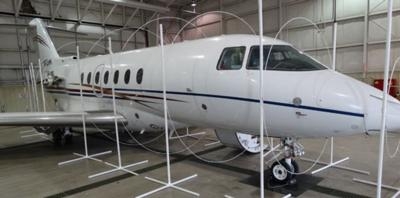Sun, Mar 29, 2015
Will Test Direct Effects Of Lightning, HIRF On Airplanes, Avionics
Wichita State University's National Institute for Aviation Research (NIAR) recently added lightning transient analysis, high intensity radio frequency (HIRF) and direct effects of lightning testing capability to the wide range of services offered by its Environmental Test and Electromagnetic Effects Labs.

Last month, NIAR completed two full vehicle lightning transient tests. The first test was for Garmin's supplemental type certificate on the Beechjet 400, followed by full vehicle tests for the Cirrus Vision SF50.
Lightning transient tests are intended to measure the actual transient levels induced into aircraft electrical wiring as a result of lightning attachment to an aircraft. This is done to ensure that the transient level does not exceed the wiring's transient control levels. To measure actual transient levels, simulated lightning currents are injected into the aircraft and the resultant currents and voltages on the wiring inside the aircraft are recorded. Stated more simply, a simulated lightning strike at a reduced level is injected onto the aircraft; the field generated by the lightning strike travels the length of the aircraft, inducing voltages and currents on wiring inside the aircraft. These voltages and currents are measured and analyzed to make sure an actual lightning strike will not damage any critical equipment during flight.

NIAR teamed with QinetiQ to perform HIRF testing for the Cirrus SF50, a newly-designed composite five-plus-two-place, single-engine turbofan-powered aircraft. The aircraft was tested using low-level swept coupling to measure the level of induced currents and voltages on system components as a result of radiated fields below 400MHz; and low-level swept fields testing above 400 MHz to determine the transfer function relating the external field to the internal bay fields at specific locations in the airframe.
NIAR will offer direct effects of lightning testing in the second quarter of 2015. With a high current generator of 200,000 amps, the lab is able to test all common lightning strike levels. Direct effects lightning testing evaluates the aircraft components' ability to resist the possible damaging effects associated with lightning attachment to the aircraft. Effects can include melting; the development of holes at points of contact; temperature rises in metal conductors; magnetic force effects; acoustic shock effects; arcing at structural bonds, hinges, and joints; and the ignition of flammable vapors within fuel tanks.
NIAR's Electromagnetic Effects lab is led by Billy Martin, a recognized expert in HIRF and lightning testing, design and certification, with more than 30 years of experience in the industry. NIAR provides a full range of RTCA DO-160 related testing and certification support; design assistance; endurance and abuse testing; and training.
(Image provided by WSU)
More News
Aero Linx: Model Aeronautical Association of Australia MAAA clubs are about fun flying, camaraderie and community. For over 75 years, the MAAA has been Australia’s largest fl>[...]
Touchdown Zone Lighting Two rows of transverse light bars located symmetrically about the runway centerline normally at 100 foot intervals. The basic system extends 3,000 feet alon>[...]
“Discovery and innovation are central to our mission at Virgin Galactic. We’re excited to build on our successful record of facilitating scientific experiments in subor>[...]
How To Get A Story On Aero-TV News/Feature Programming How do I submit a story idea or lead to Aero-TV? If you would like to submit a story idea or lead, please contact Jim Campbel>[...]
Student Pilot Reported That During Rotation, “All Of A Sudden The Back Of The Plane Kicked To The Right..." Analysis: The student pilot reported that during rotation, “>[...]
 ANN's Daily Aero-Linx (05.02.24)
ANN's Daily Aero-Linx (05.02.24) ANN's Daily Aero-Term (05.02.24): Touchdown Zone Lighting
ANN's Daily Aero-Term (05.02.24): Touchdown Zone Lighting Aero-News: Quote of the Day (05.02.24)
Aero-News: Quote of the Day (05.02.24) ANN FAQ: Contributing To Aero-TV
ANN FAQ: Contributing To Aero-TV NTSB Final Report: Cirrus Design Corp SR20
NTSB Final Report: Cirrus Design Corp SR20




